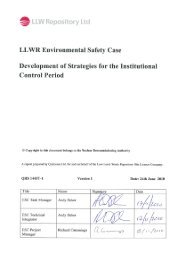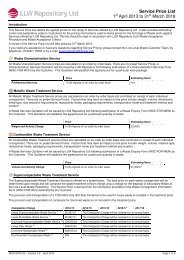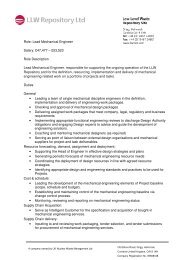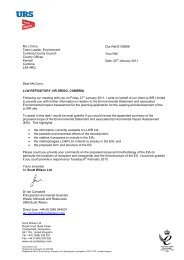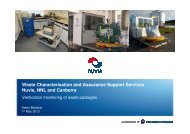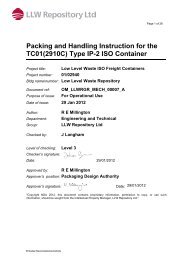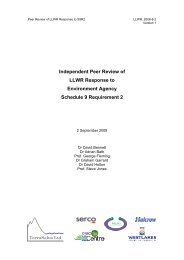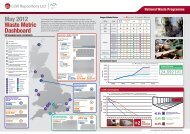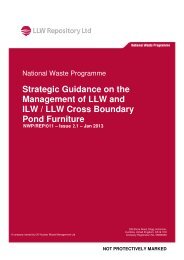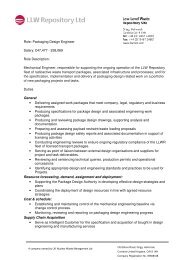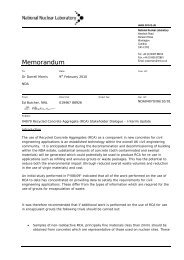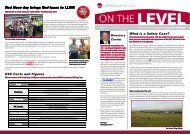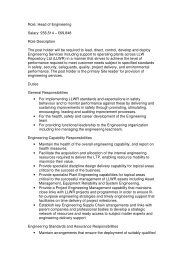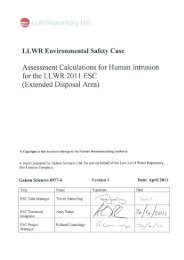Developed Operational Strategy - Low Level Waste Repository Ltd
Developed Operational Strategy - Low Level Waste Repository Ltd
Developed Operational Strategy - Low Level Waste Repository Ltd
You also want an ePaper? Increase the reach of your titles
YUMPU automatically turns print PDFs into web optimized ePapers that Google loves.
LLWR <strong>Developed</strong> <strong>Operational</strong> <strong>Strategy</strong>10009/LLWR/LTP Date: March 2010Thorough segregation/categorisation is essential to accomplishing the following objectives:• Preventing and minimising waste generation by controlling radioactive materials and maintainingcontrols necessary to prevent cross contamination of clean wastes• Optimising the use of waste treatment technologies including decontamination, metal treatment,compaction, and incineration• Driving waste categorisation to the most cost effective disposal path commensurate with therequired levels of safety, security and environmental protection. Emphasis will be placed ondriving waste volumes in priority order to exempt wastes, very low level wastes and low levelwastesThe LLWR provides packaging solutions to facilitate segregation of wastes. Consignor supportrepresentatives also provide training to consignor waste management personnel, support consignorimplementation of standardised waste management procedures, and facilitate sharing of wastemanagement lessons learned. Changes have been implemented to the LLWR CFA and pricing systemto appropriately incentivise consignor behaviour following wide ranging and appropriate consultation.4.3.3 <strong>Waste</strong> Treatment<strong>Waste</strong> treatment includes a wide range of processes to reduce the volume of waste requiring disposal bychanging the physical form of the waste or by removing surface contamination. Analysis of the UK LLWinventory indicates that over 60% of LLW and 32% of VLLW could potentially be treated using a varietyof techniques to reduce volumes.For metallic wastes, treatment processes such as surface decontamination (e.g. grit-blasting) andmelting can recycle over 95% of the incoming metal. Recycling of radioactive metal aligns strongly withthe principles of the waste hierarchy and resource conservation and also helps preserve the capacity ofthe LLWR by reducing final waste disposed as LLW to less than 5% of the original waste.Government LLW Policy states that there is scope for greater use of thermal treatment processes suchas incineration for combustible solid LLW and liquid LLW streams such as contaminated oils. Followingtreatment, waste volumes are typically reduced by over 98% and the resulting residues are stable, inertand suitable for disposal.The benefits achieved by compaction have been demonstrated by compactors operating in the UK, U.S.and Europe. Compaction reduction efficiencies achieved at facilities such as the <strong>Waste</strong> Monitoring andCompaction Facility (WAMAC) at Sellafield and mobile compaction units average around 5:1, dependingon the material.The Government LLW Policy permits the treatment of waste in overseas facilities, in light of anassessment of all near-term practicable options, for the recovery of re-useable materials or treatmentthat will make its subsequent storage and disposal more manageable.There is a significant amount of spare capacity worldwide in existing licensed commercial facilities andhence these routes could potentially play a significant part in helping to preserve the strategic resourceof existing capacity at the LLWR in the short and medium term. As the need for and use of treatmentroutes increase in the long term, there will be a strategic need for UK facilities.Page 20 of 62



